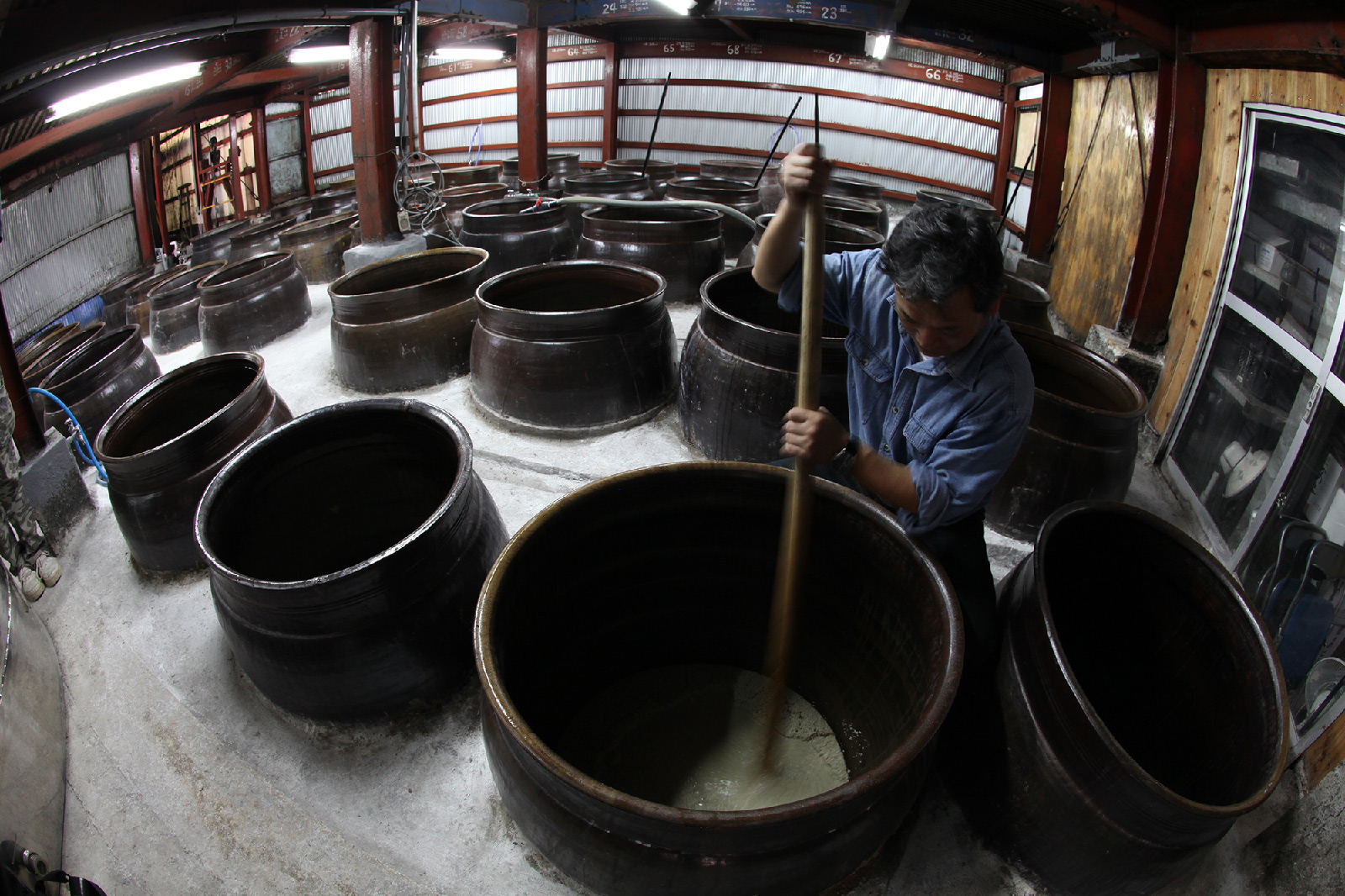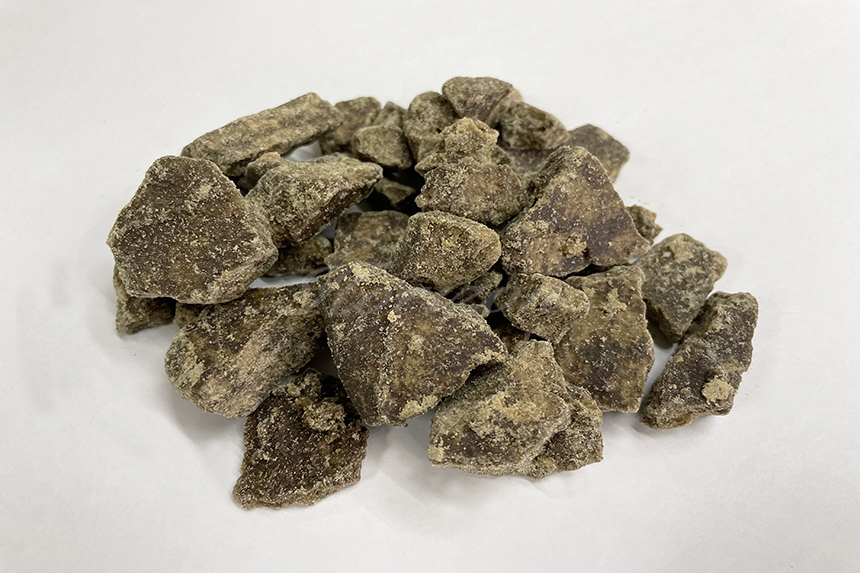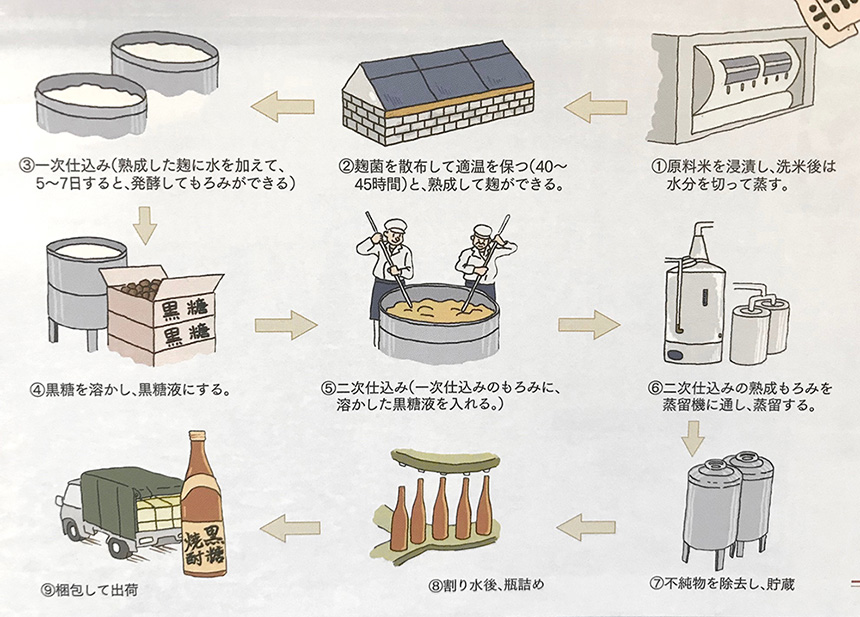
Amami Cuisine
History of Amami Brown Sugar Shochu
Amami Brown Sugar Shochu
Distilled spirits made exclusively in Amami
There is a type of distilled spirits made from brown sugar, which is made only in the Amami Islands. It is Amami brown sugar shochu.
It is a distilled beverage like brandy and whiskey, but it has a clear color and zero sugar content. Each sip brings a gentle aroma of brown sugar, which is made from sugarcane, a mellow flavor of rice-malt. Shochu has been enjoyed by many as an authentic spirits (honkaku shochu), evoking the nature and passion of Amami to people who taste it. In recent years, the spirits have won a number of world-class contests and the reputation of shochu has been spreading worldwide.

Amami Brown Sugar
Authentic shochu is good for health
Studies have shown that shochu and other authentic distilled spirits are less likely to cause a hangover. Shochu can help prevent blood coagulation in arteries by thinning blood at a significantly higher level compared to other alcoholic beverages. These features have made shochu widely popular as a healthy adult beverage.
Distilled Spirits of the World
It is said that distillation to create spirits started in ancient Greece, when Aristotle experimented with distillation techniques. The same method had created brandy, whiskey and vodka in the West that traveled the Silk Road to the East. In India it became arrack, baijiu in China, rao ron in Thailand. When it reached Ryukyu, it produced awamori. And finally when the use of sugarcane was introduced to the Amami islands, it came to become what we now know as shochu was born.
History of Amami Shochu
While it is not clear when the production of shochu started in Amami. The islands were placed under the control of the Satsuma feudal clan in 1609 after nearly a century-long the tutelage of the Kingdom of Ryukyu. Given that the islanders were ordered to pay distilled spirits in tribute in 1623, it is believed that distillation techniques had already existed before that time.
Sagenta Nagoya, a Satsuma clansman who had been exiled to Amami Oshima wrote Nantou Zatsuwa (Various Stories of South Islands) (1850 – 1855), a collection of illustrations and writings of daily lives in the islands. It depicted a scenary of shochu production, with illustrations of chinquapin, millet and cycad among other nuts being used to make various types of distilled spirits. Nagoya described, “there are occasions when a transparent liquid from sugarcane is added to spirits which locals would call tomejiru shochu,”indicating that this might have been the origin of shochu.
However, at the time, the Satsuma clan had a monopoly on brown sugar, and common people did not have access to it. The Satsuma clan also prohibited distillation during the sugar refining season.
(Photo: Illustration of “a warming up and dripping shochu”, by
Sagenta Nagoya from Nantou Zatsuwa, Possession of the Amami Museum}
In the Meiji period, a secret recipe for making awamori was brought into Amami from Okinawa, which led to a surge of home distilling. The distillation of alcohol at home was prohibited in 1899, but people continued the practice secretly. The Amami Islands were placed under the American administration after World War II, various distribution routes to and from the mainland. Availability of rice for everyday consumption was also drastically reduced, and brewers substituted the rice, which was normally used to make malt, with barley and potatoes. However, as there were no buyers for such spirits, people began to use left-over brown sugar to produce spirits, which thus opened up a production method of Amami shochu as we know today.
When Amami was returned to Japan in December 1953,the government acknowledged how shochu had been produced by the local people up to that time. The Amami Islands became the only place in Japan where they were allowed to use brown sugar to produce liquor with a stipulation that it be used in combination with rice malt under a very special exception to the Liquor Tax Law.

Sugarcane
Differences between Shochu and Rum
Rum is made from molasse through a single fermentation. Under Japanese Liquor Tax Law, It is categorized as Western spirits. On the other hand, the production of Amami shochu involves two stages. On the first stage, malted rice is fermented, and then a block of dissolved brown sugar before another fermentation on the second stage. This two-stage method distillation creates an aroma and a profound richness, which characterizes an authentic (single distillation) spirits. The liquor tax is also cheaper than that of ram.
Amami Shochu Today
Now there are 26 distilleries on five of the Amami Islands, producing around 170 different brands of shochu, including the 18 well-known brands. The reason for such a diversity lies in the different ways of production at each distillery, as well as the available natural resources of the islands.
Water is one of the key ingredients. As Kikaijima, Okierabujima and Yoronjima were formed by elevated coral reefs, the water there contains a lot of minerals, such as calcium and magnesium (generally called hard water). On the other hand, Amami Oshima has many mountains and forests and is made up of old stratum; the water there contains less minerals (called soft water). Tokunoshima has both of these features, having hard and soft water supplies. Such diverse characteristics give a rise to different ways of making shochu on islands to islands.
There are two ways to distill shochu at present time. One employs a traditional atmospheric distillation that capitalizes on the flavors of ingredients. Another method is a vacuum distillation which creates a milder aroma and flavor.
Furthermore, malted rice is used in the first fermentation and brown sugar is added and dissolved in the second fermentation to produce Amami shochu.
Introduction of Amami Archipelago and Home of Shochu
The Amami Archipelago is made up of Amami Oshima, Kakeromajima, Ukejima, Yorojima, Kikaijima, Tokunoshima, Okienorabujima and Yoronjima. These islands stretch across the Pacific from Amami Oshima, which is located approximately 380 km south-southwest of Kagoshima City, to Yoronjima, which exists 23 km from the northern tip of the main island of Okinawa.
It has a subtropical oceanic climate, with a warm temperature of an average of 21 C degrees throughout the year. Each of the beautiful islands with its distinct features is home to rare species of animals and plants. This uniqueness has made the island group as a candidate site for the World Natural Heritage. Island songs and dances and other parts of the fundamental culture of Japan are also vibrantly alive on the islands.
Making brown sugar shochu

Making brown sugar shochu
- After rice is soaked and washed, it is drained and then steamed.
- Spread friendly fungus (Koji-kin) over the rice and keep it at a moderate temperature for 40 – 45 hours to get it ripened to form malted rice (koji).
- First preparation (added water to the ripened malted rice, and let it sit to ferment for 5 – 7 days to create mash.)
- Dissolve brown sugar to make a sugar solution.
- Secondary preparation (The sugar solution is added to the mash from the first preparation.)
- Add ripened mash from the secondary preparation to the distiller to start the distillation process.
- Remove impurities and store the unprocessed spirits.
- Dilute the unprocessed spirits with water and bottle it.
- Introduction of Amami Archipelago and Home of Shochu
Photo and captions / HORIZON Editorial Office

